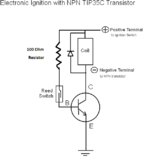ElectroNovice
Newbie
I am looking to replace the old mechanical points on a vintage British twin motorcycle. I have switched over the polarity to a negative ground to be compatable with several LED's. I have kept the mechanical advance but replaced the cam lobe with a magnet. The magnet acts on a pair of Reed Switches to open and close the timing and are used in turn to switch off and on the current to the ignition coils via a BJT transistor - the Reed switches cannot handle the current needed to drive the coils. In this case I am using a TIP35C whose Base is connected to the Reed Switches which in turn are fed by a positive lead. The Emitter is connected to the negative ground while the Collector supplies the positive terminal of the ignition coil. Two questions remain: I believe I need a resistor ahead of the transistor Base to prevent burning out the transistor. I suspect that I need something in the order of a 100 Ohm resistor with a minimum 2W rating. Is this correct? I also believe a diode placed in reverse bias across the coil terminals is required to protect the transistor from the transient flyback voltage spike created when the coil primary voltage collapses. Again, please correct me as I do not have an electronics background and have jumbled my plans together from reading online and copying a similar postive ground device lacking any protective resistors or diodes.. Having sought advise elsewhere only to receive a litany of conflicting direction as well as my thread hacked to discuss several other alternatives , I believe this to be a more professional forum to post my question. I have tried the commercial electronic ignitions and found them although reliable,not providing any performance improvement. The gain obtained from the transistor's should improve performance. My elementary schematic is attached Thank you
